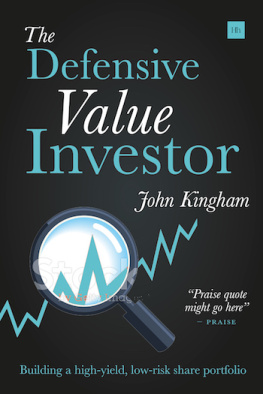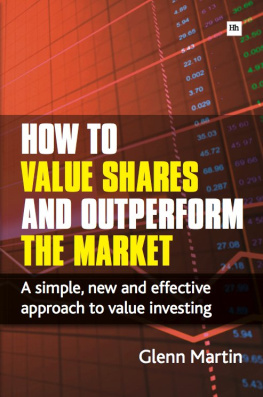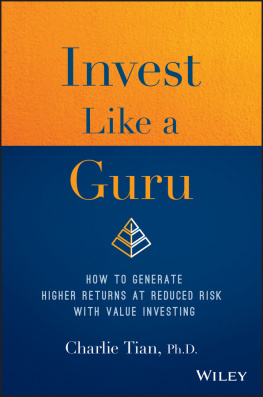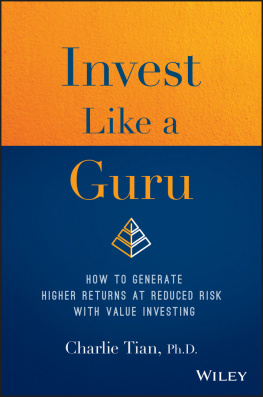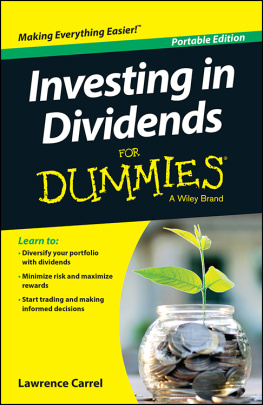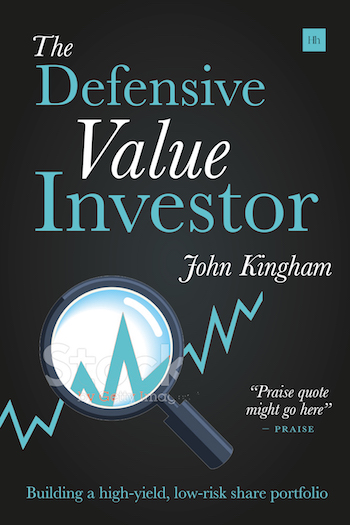The Defensive Value Investor
A complete step-by-step guide to building a high-yield, low-risk share portfolio
By John Kingham
HARRIMAN HOUSE LTD
18 College Street
Petersfield
Hampshire
GU31 4AD
GREAT BRITAIN
Tel: +44 (0)1730 233870
Email: enquiries@harriman-house.com
Website: www.harriman-house.com
First published in Great Britain in 2016
Copyright John Kingham
The right of John Kingham to be identified as the author has been asserted in accordance with the Copyright, Design and Patents Act 1988.
Print ISBN: 978-0-85719-398-8
eBook ISBN: 978-0-85719-533-3
British Library Cataloguing in Publication Data
A CIP catalogue record for this book can be obtained from the British Library.
All rights reserved; no part of this publication may be reproduced, stored in a retrieval system, or transmitted in any form or by any means, electronic, mechanical, photocopying, recording, or otherwise without the prior written permission of the Publisher. This book may not be lent, resold, hired out or otherwise disposed of by way of trade in any form of binding or cover other than that in which it is published without the prior written consent of the Publisher.
Whilst every effort has been made to ensure that information in this book is accurate, no liability can be accepted for any loss incurred in any way whatsoever by any person relying solely on the information contained herein.
No responsibility for loss occasioned to any person or corporate body acting or refraining to act as a result of reading material in this book can be accepted by the Publisher, by the Author, or by the employers of the Author.
Contents
About the Author
John Kingham is an experienced private investor, investment blogger and newsletter publisher. His professional background is in computer software for the insurance industry, where he worked for clients ranging from Lloyds syndicates to some of the worlds largest general insurers.
In 2011 John left the computer software industry and began publishing UK Value Investor , a monthly newsletter for defensive value investors.
John currently lives in Kent with his wife and son. His website can be found at: www.ukvalueinvestor.com
Preface
What this book covers
This book takes you step-by-step through a simple but comprehensive strategy for investing in the stock market. The strategy is called defensive value investing for obvious reasons: it combines elements of both defensive investing and value investing.
On the one hand, defensive investing is about buying the shares of high-quality companies that have been around for many years, paying and steadily growing their dividends. It also goes beyond stock selection and requires some thought about how a portfolio is structured, such as how many companies it should hold, which industries and countries those companies operate in, and so on.
On the other hand, value investing focuses primarily on whether or not a companys shares represent good value for money at their current price. A value investor would say that even if you found the most defensive company in the world, it might still turn out to be a bad investment if you pay too much for it.
Defensive value investing is therefore about buying relatively defensive companies at value for money prices. The specific strategy in this book is based on a series of rules of thumb which turn the theory into a checklist of simple and actionable statements.
Ill cover enough theory so that you can clearly understand why each part of the strategy is there, but this is primarily a practical book to be used as an aid to real-world investing, rather than just as an interesting read.
To help you see how this strategy can be applied in the real world, Ive included many examples of actual investments I have made in recent years.
Who this book is for
This book is for you if youre looking to invest directly in the shares of individual companies rather than, or in addition to, collective investment vehicles such as unit trusts. More specifically, it is for those who want to invest in relatively large and successful companies, usually with high dividend yields and long records of profitable dividend growth.
You should be looking to invest at least 30,000 into a broadly diversified portfolio of defensive value stocks. I think that amount is a reasonable minimum because the strategy involves holding around 30 stocks, which gives an average investment per holding of 1000. At that size a typical 10 broker fee on both the buy and sell trade would amount to 2% of each investment, which is the most I would want to pay. With smaller portfolios these fixed broker fees can become a significant drag on returns.
Defensive value investing is a long-term investment approach suitable for long-term investors. Although long term is somewhat ambiguous, I would typically expect each stock to be held for between one and ten years, and around five years on average. This is not a get-rich-quick scheme.
The strategy requires at least one stock to be bought or sold each month, so this book is not really suitable for buy-and-hold or buy-and-forget investors. Having said that, any investment analysis should take no more than a few hours each month to carry out, so although this is an active investing strategy it is by no means full-time.
In terms of your existing knowledge, you should already have a basic understanding of investing and company accounts. You wont need to be an accountant, but you should at least know what balance sheets, income statements and cash flow statements are. You should also understand basic terms such as: assets and liabilities; revenues, expenses and profits; and market capitalisation, dividends and rights issues.
I have tried to explain everything as clearly I can but if you find some of the terms or concepts unfamiliar I would suggest you read an introductory book first, such as Rodney Hobsons Shares Made Simple .
How this book is structured
This is very much a step-by-step book and each chapter builds upon the ideas laid down previously, so its important that you read it in order. The chapters are divided into three parts and an appendix.
Part 1: Analysing a Companys Accounts
Most investors like to think about which company to buy next, so Ill cover that first. In this section, Ill go through how to select companies based on their past financial results, such as historic revenues, earnings and dividends. This is an important first step because a companys financial track record says a lot about how defensive that company might be.
What well be looking for here are companies with long and unbroken records of dividend payments, strong and consistent growth, good profitability and robust balance sheets.
We will also begin to look at whether or not a companys shares might be good value by comparing their current price against the historic earnings and dividends.
Part 2: Analysing a Companys Business
Having found a good company at an attractive price our next step is to build up a general understanding of what the company does and how it does it. After that well look at whether it has any durable competitive advantages and whether it might be a value trap (i.e. the company has some problems which mean it isnt worth as much as its past results would suggest).

